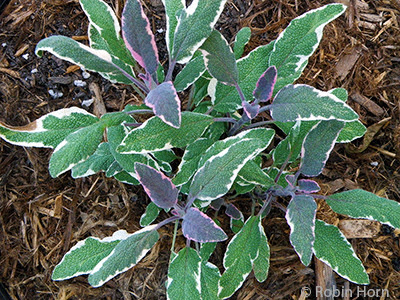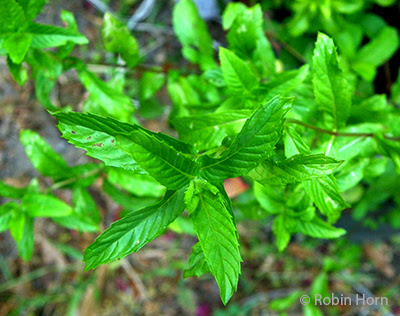 |
| Sweet Basil: Everyone's Favorite Garden Herb |
Suggestions by Robin
Back in the days when I lived in the not-so-great part of
Santa Cruz, before the city added street lights to discourage nefarious trades of
all kinds, my landlord inhibited my attempts to have a garden by sudden yard
activities. One time I came home the yard was shorn into a badminton court.
Another time, horse poop was scattered all over everything. Another time the deck
was ripped up, along with the jade plants I’d started growing next to it. Being
a compulsive gardener and purchaser of seedlings, I began growing just about
any plants that came my way in pots. Herbs, whether annual or perennial, are
most practical. Not only do they add spark and finesse to meals, a line of
herbs in same-size pots adds charm and elegance to even the most Spartan-looking landscapes. Here are 10 of my favorite pot-friendly herbs.
 |
| Thai Basil: Pinch off Flowers for Better Leaves |
1. Basil: Everyone’s
favorite pesto herb is so easy to grow and comes in so many varieties you’ll
probably want more than one plant. Sweet basil is classic in combination with
tomatoes or in any Mediterranean recipe. Thai basil, with its slightly peppery
and minty notes adds defining flavors to southeast Asian cuisine. Lemon basil,
lime basil, cinnamon basil, and small-leaf basil have culinary as well as
decorative appeal. Holy basil (tulsi) has medicinal and spiritual uses. Opal
basil and other purple varieties add color to the garden and to salads, but
will make the least appetizing pesto imaginable. Trust me, I’ve tried it.
Protect your basil from slugs and snails with a strip of copper tape around the pot top.
2. Oregano:
Indispensable for Italian cooking, oregano adds zest to soups, salad dressings,
tomato sauces, chicken, fish, and vegetable dishes. It combines well with other
herbs like parsley, marjoram, thyme, and rosemary, and is often sold dried in
combination with these. Greek (sometimes called Italian) oregano is considered
the best culinary species. The plant is perennial even in pots if the winter is
mild enough. Throw some shade cloth over it or protect it beneath shrubs if
below-freezing temperatures are prolonged.
 |
| Marjoram Looks a Lot Like Oregano |
3. Sweet Marjoram:
Closely related to oregano (same genus), sweet marjoram combines well with
oregano in most dishes. Its flavor has been described as somewhat piney and
citrusy. Its attractive leafy growth pattern enhances the patio, similar to
oregano. A tender perennial, it can survive occasional freezes. If covered with
shade cloth during prolonged freezes, it can survive throughout most
Mediterranean climate winters in a pot.
4. Thyme: Another
semi-hardy perennial, thyme’s tiny leaves and purplish-white blossoms are a
fetching addition to the herb garden. The ancient Greeks and Romans believed
that thyme was a source of courage. Thyme is essential to bouquet garni,
tied-up sprigs of thyme, bay, and other herbs used to flavor soups and
stews. Thyme is great with beef or eggs, and the strong flavor imparted by its
tiny leaves should not be underestimated; use thyme with a lighter hand
than oregano or marjoram. Various citrus flavored thymes are fun to grow:
orange, lemon, and lime thymes. I grew an elegant if somewhat culinarily
useless rose thyme once that lasted several years before getting heat-shocked.
Do protect your potted thymes from unrelenting sun on hot days.
5. Winter Savory:
Another perennial herb with tiny leaves and an appealing growth pattern.
Although not nearly as popular as other herbs in the kitchen, its hardiness and
ease of cultivation make it worth adding to the garden. It has a spicy flavor,
making it a commonly used herb for homemade
sausage. It also compliments meats, poultry and beans, but prolonged
cooking will weaken its strong flavor significantly. Summer savory tastes
similar, and is a tender annual. I’ve not had much luck with it in pots, but
you might want to experiment with it anyway.
 |
| Culinary Sage: Beautiful But Can be Finicky |
6. Sage: It's beautiful, but don't expect it to last more than a couple of years, if that. Heat, cold, and unknown factors always seem to shock sage so that it dries up and dies. But during the summer and fall, enjoy fresh sage leaves in vegetable dishes, meat marinades, and stuffing for chicken. If you get more than one season from it, revel. If not, pick the drying leaves as it dies and keep them for winter soups, stews, and holiday menus. Think butternut squash ravioli with sage butter, or anything else with sage butter.
7. Cilantro: My
second-favorite annual (after basil), cilantro, can be planted in pots or
directly in the garden, though like basil you might need to protect it from snails and slugs. A traditional seasoning in both Chinese and
Mexican cookery, cilantro also compliments salads and sauces (and of course
salsas). It grows readily from seeds or seedlings. Its one disadvantage to the
gardener is its tendency to bolt, or go to seed. When it does, its broad leafy
growth (the part we eat) turns thin and spindly. Cut back the flowers as they
form to avoid bolting, sow in filtered sun, and/or plant several times during
the season. Renee’s Garden sells slow-bolt seeds that work true to their name. And if a plant or two goes to seed in
the yard, you’ll likely have cilantro growing next year with little effort.
 |
| Persian Mint: For Cooking and Drinks |
8. Mint: With so many
mint varieties available, you might want to plant a few pots! Many do well in
the ground as well, but at our house my favorite, Persian mint, grows best in a
container. Spearmint is the classic mint julep (or mojito) ingredient, and easy
to grow; in fact you might want to confine it to a pot so it doesn’t overtake
your garden. Orange and lemon mints add interest to both sweet and savory
sauces and marinades as well as drinks. And who can resist trying chocolate
mint? Grow your mints in the shade with adequate water, and cover the pots in
winter during freezes for best longevity.
9. Rosemary: Being a
shrub or woody-growth creeper, rosemary probably prefers to be in the ground,
but can live contentedly in a large container for years. It’s cold and drought
tolerant, but avoid heat shock by keeping it in partial shade during the
hottest months and remember to water it every week or so to keep it happy. I
also cover it with shade cloth when temps dip below freezing, though this isn’t
necessary if it’s protected between larger shrubs. Rosemary is a classic
compliment to lamb or chicken, and it’s also tasty in soups, stews, grilled
portobellos, and even eggs. A little goes a long way, so easy does it.
 |
| Newly Planted Lavender with Winter Savory in Background |
10. Lavender: Although
not strictly an herb, lavender adds beautiful purple blossoms and lovely
fragrance to the herb garden. Like rosemary, it grows happily in containers as
long as its watered, kept from heat-shock, and covered during winter freezes.
Lavender spikes are fragrant cut flowers, and some varieties can be hung upside
down until dry for fragrant arrangements, or to preserve the buds for culinary
use. Lavender buds are used in tea infusions, and such tea may be used to
flavor baked goods. Occasionally buds are baked whole, as in lavender
shortbread or scones. Lavender is an ingredient in most Herbes de Provence blends, mixtures of "French" spices invented by
Americans in the 1970s—although lavender was never used in Provencal cooking.
But why wouldn’t someone use a bit of artistic license, if the results taste
good?
Got other favorite herbs that you grow in pots? Let readers
know about them in a comment!
 |
| Potted Herbs Brighten Even the Most Spartan Landscapes |







grow herbs i think use hydroponic system will better than soil, although its very complicated
ReplyDelete